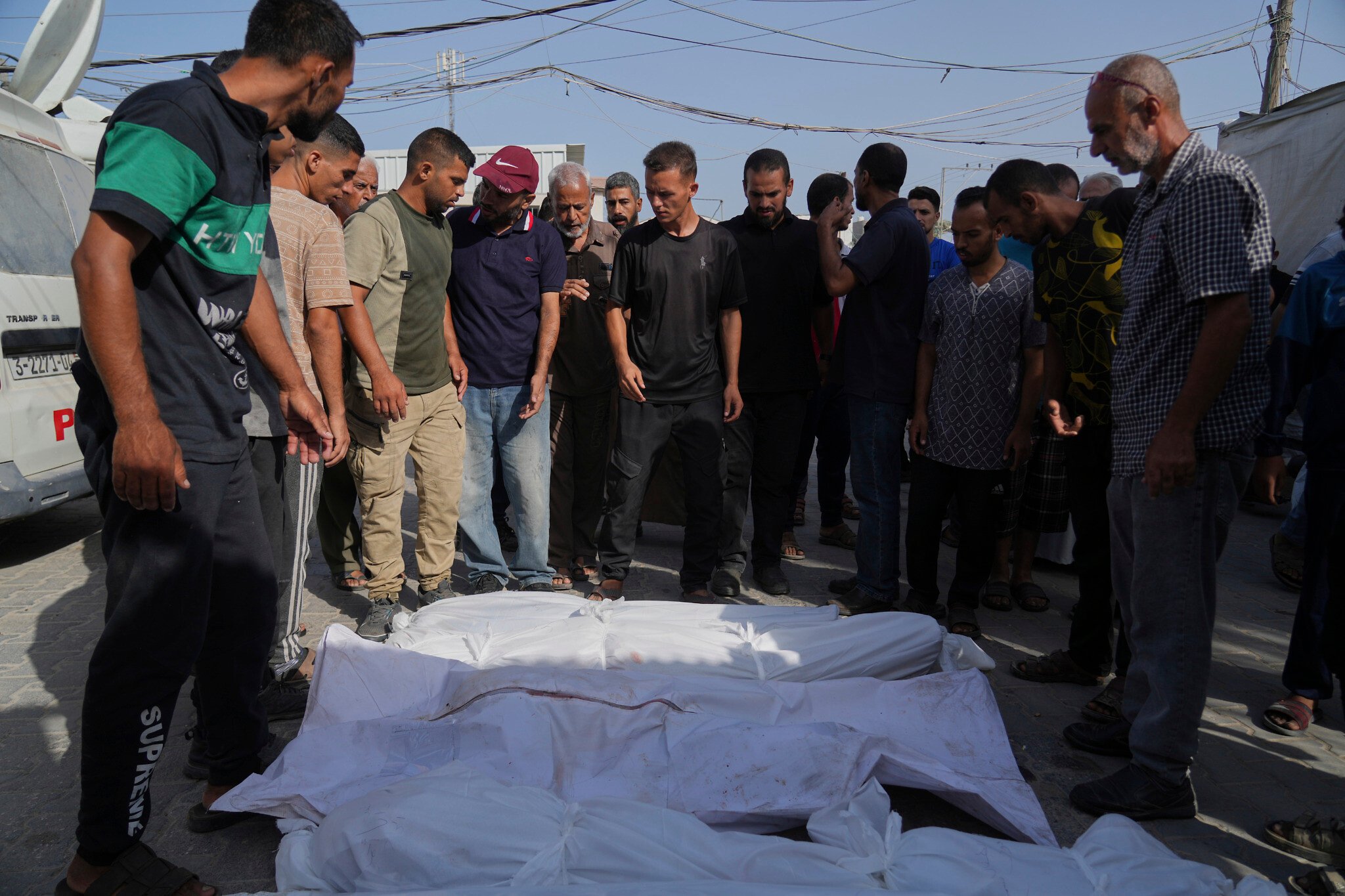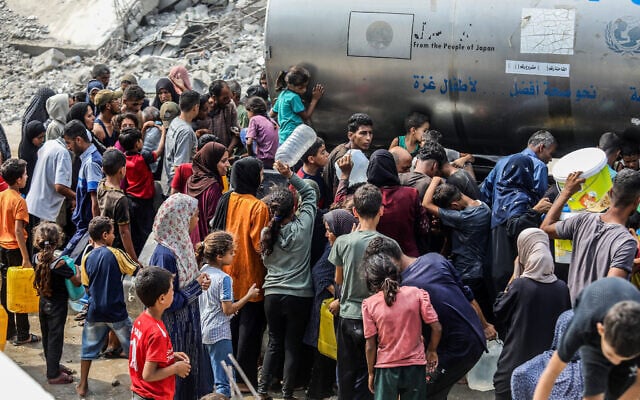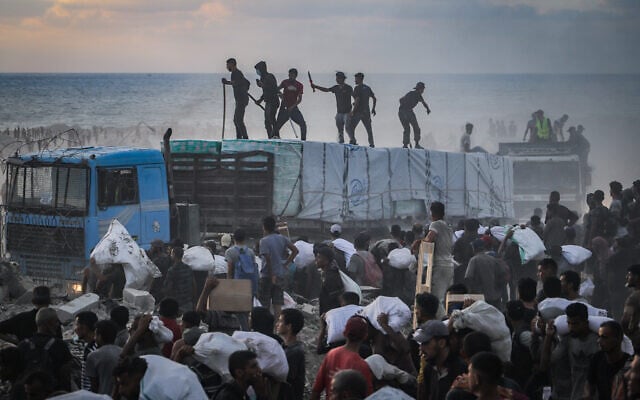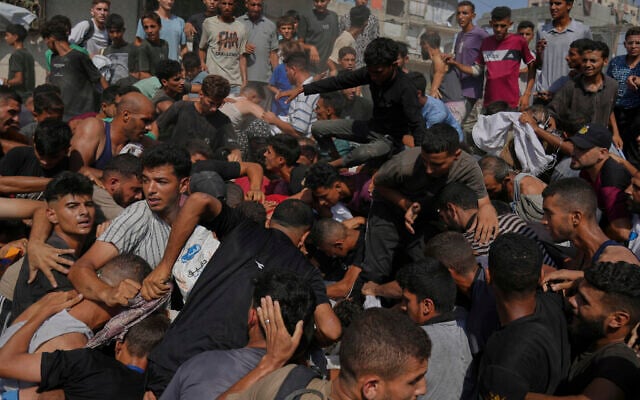



At least 25 Palestinians were reported to have been killed in Israeli airstrikes across the Gaza Strip on Tuesday morning, according to medical sources cited by Palestinian media as Israel’s Gaza City offensive loomed and aid groups stepped up efforts to get food to Gazans.
The tolls cited by Palestinian media were not verified, and there was no comment from Hamas authorities in the Strip. The Israel Defense Forces did not comment on the reports, but said it was looking into the cases.
In one instance, a drone strike overnight in central Gaza’s Deir al-Balah was said to have hit a tent housing displaced people, killing five. Among the dead were a 1-year-old, two children ages 12 and 13, and two adults.
A separate strike in Deir al-Balah early Tuesday morning killed five people, according to Palestinian media.
Another eight people were said to have been killed in southern Gaza’s Khan Younis.
The reported deaths came after Hamas said on Monday that it had informed mediators that it accepted the ceasefire hostage release deal proposal submitted to the terror group the day before.
Sources have said that the deal involves a 60-day pause and the release of 10 living captives, as mediators scramble to find an agreement before Israel launches its planned mission to conquer Gaza City, in the enclave’s north.
Prime Minister Benjamin Netanyahu seemed to dismiss Hamas’s response, however, and signaled that Israel was moving forward with its plan to take over the Palestinian enclave’s largest city and transfer its population to the south.
“We can clearly see that Hamas is under immense pressure,” was all the premier had said.
Meanwhile, the international community was keeping up its push on Tuesday to flood the Strip with as much humanitarian aid as possible, as a ship loaded with 1,200 tons of food supplies bound for Gaza approached the port of Ashdod in southern Israel.
The Panamanian-flagged vessel was loaded with 52 containers carrying food aid such as pasta, rice, baby food and canned goods.
Israeli customs officials had screened the aid at the Cypriot port of Limassol, from where the ship departed on Monday.
Some 700 tons of aid was provided by Cyprus, purchased with money donated by the United Arab Emirates to the so-called Amalthea Fund, set up last year for donors to help with seaborne aid.
The rest came from Italy, the Maltese government, a Catholic religious order in Malta, and the Kuwaiti nongovernmental organization Al Salam Association.
“The situation is beyond dire,” Cyprus Foreign Minister Constantinos Kombos told The Associated Press.
Cyprus was the staging area last year for 22,000 tons of aid delivered by ship directly to Gaza through a pier operated by the international charity World Central Kitchen and a US military-run docking facility known as the Joint Logistics Over-the-Shore system.
By late July 2024, aid groups pulled out of the project, ending a mission plagued by repeated weather and security problems that limited how much food and other emergency supplies could get to those in need.
Shipborne deliveries can bring much larger quantities of aid into Gaza than the air drops that several nations have carried out since Israel allowed them to resume on July 27 under immense international pressure.
Most of the aid to the territory arrives via trucks.
The Cypriot Foreign Ministry said Tuesday’s mission was led by the United Nations but was a coordinated effort — once offloaded in Ashdod, UN employees would arrange for the aid to be trucked to storage areas and food stations operated by the World Central Kitchen.
The charity, run by celebrity chef José Andrés, is widely trusted in the battered territory.
“The contribution of everyone involved is crucial and their commitment incredible,” Kombos said.
Images of starving Gazans drew international outrage last month and heaped pressure on Israel until, on July 27, it announced measures to allow more aid into the Strip.
But aid agencies warned that the partially eased measures — including restarting the practice of airdropping supplies into Gaza — were not enough to fill the gap created by long months of little to no aid entering the Strip.
And the UN on Tuesday reiterated its accusations that while Israel is letting some supplies into the Gaza Strip, it is not enough to avert widespread starvation
“In the past few weeks, Israeli authorities have only allowed aid to enter in quantities that remain far below what would be required to avert widespread starvation,” UN human rights office spokesperson Thameen Al-Kheetan told a Geneva press briefing.
He added that the risk of starvation in Gaza was a “direct result of the Israeli government’s policy of blocking humanitarian aid. Israel’s military agency that coordinates aid, the Coordinator of Government Activities, said Israel invests “considerable efforts” in aid distribution to Gaza.
On Monday, some 370 trucks carrying humanitarian aid entered the Gaza Strip through the Kerem Shalom and Zikim crossings, COGAT said.
According to COGAT, about 350 trucks’ worth of aid were also collected by the United Nations and other international organizations from the Gaza side of the crossings on Monday to be distributed.
“The contents of hundreds of trucks are still awaiting collection on the Gaza side of the crossings,” COGAT said.
Another 180 pallets of aid — about 6-9 trucks’ worth — were airdropped by Jordan, the UAE, Germany, Belgium, Italy, France, the Netherlands, Singapore, and Indonesia in Gaza on Monday, according to the IDF. Each pallet has about one ton of food.
Similar amounts of aid deliveries have been reported daily for approximately the past week.
The UN has said 600 trucks of aid need to be distributed each day in order to properly feed the Strip’s roughly two million people amid the war.
In addition to the supplies being trucked into Gaza from Israel, the US- and Israel-backed Gaza Humanitarian Foundation announced on Sunday that it was launching a new system to enable families to reserve a box of aid in advance, as it tries to reduce the scenes of utter chaos at its aid distribution sites.
To date, aid has been distributed on a first-come-first serve basis, benefiting younger, healthier men who are able to weather the long, dangerous trek through IDF lines to reach GHF distribution sites.
GHF has tried to alleviate the inequity by establishing women’s-only distribution times, but more vulnerable populations continued to be neglected.
Under the new system, GHF’s local Palestinian staff will invite beneficiaries to participate. Those who opt in will have their photo taken and receive an ID card with a unique number on it.
Beneficiaries will also have the option of creating an online profile where they can input information such as household size.
Participants will then have their designated box of food set aside for them, eliminating the need to partake in the daily rush for aid.
The system will also enable GHF to directly communicate with participants regarding distribution times and other relevant updates, it said.
GHF stressed that all data would be securely stored and never shared, in an attempt to alleviate the concerns of Gaza’s civilians that their information would be shared with Israeli authorities, with whom the aid organization closely coordinates.
The new initiative is voluntary and will operate in parallel to the existing first-come-first-served system, GHF said.
The aid group said it had launched a pilot of the initiative on Sunday with 350 participants at one of its Rafah distribution centers and that it was planning to scale it up in the coming weeks.
Experts have long argued that a registration process for GHF aid recipients was essential, as the free-for-all, chaotic scenes at distribution sites have seen boxes snatched within minutes, with no way to determine who was benefiting from the aid.
“It has always been our plan to offer a way for families to reserve aid in advance and guarantee access, just as other aid organizations do,” said GHF executive director John Acree of the new plan.
“Until now, however, conditions on the ground have made implementation of such a program impossible. But with more aid flowing into Gaza and GHF’s deliveries helping stabilize food availability, conditions are improving.”
Still, GHF is only able to serve a small fraction of Gaza’s population of roughly two million, as it is currently operating three sites in the entire Strip. Israeli and US officials have indicated that they plan to scale up GHF’s operations, but aid from other international organizations amounts to the bulk of assistance feeding Gazans.
On top of food supplies, COGAT said on Sunday that it would renew the supply of tents and shelter equipment to Gaza, ahead of plans by the military to evacuate the civilian population of Gaza City.
The IDF is currently carrying out an operation in the Zeitoun neighborhood on the outskirts of the city, where the Hamas-run civil defense agency said residents had little to no access to food and water amid the heavy bombardment.
The spokesman for the civil defense, Mahmud Bassal, said conditions in Zeitoun were rapidly deteriorating, and that the majority of the roughly 50,000 people there were lacking “the basic necessities of life.”
Israel strongly denies limiting aid supplies and accuses Hamas of exploiting deliveries to boost its military capabilities.
The Hamas-run Gaza health ministry says more than 60,000 people in the Strip have been killed or are presumed dead in the fighting so far, though the toll cannot be verified and does not differentiate between civilians and fighters. Israel says it has killed some 20,000 combatants in battle as of January 2025, and another 1,600 terrorists inside Israel during the October 7 onslaught.
Israel has said it seeks to minimize civilian fatalities and stresses that Hamas uses Gaza’s civilians as human shields, fighting from civilian areas including homes, hospitals, schools and mosques.
Israel’s toll in the ground offensive against Hamas in Gaza and in military operations along the border with the Strip stands at 459. The toll includes two police officers and three Defense Ministry civilian contractors.
Times of Israel staff contributed to this report.





